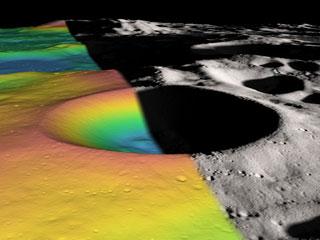
Shackleton crater at the Moon's south pole. The huge crater, named after the Antarctic explorer Ernest Shackleton, is two miles deep and more than 12 miles wide. Photo: NASA/Zuber, M.T. et al., Nature, 2012.
LONDON (PTI): Scientists have found that small patches of ice could make up five to 10 per cent of material inside a permanently shadowed lunar crater located near the Moon's south pole.
The small tilt of the lunar spin axis means Shackleton's interior is permanently dark and very cold. Researchers have long thought that ice might collect there.
Scientists using the Mini-RF radar on NASA's Lunar Reconnaissance Orbiter (LRO) have estimated the ice percentage by weight, according to the team led by Bradley Thomson at Boston University's Centre for Remote Sensing.
"These terrific results from the Mini-RF team contribute to the evolving story of water on the moon," says LRO's deputy project scientist, John Keller of NASA's Goddard Space Flight Centre, the Geophysical Research Letters report.
"Several of the instruments on LRO have made unique contributions to this story, but only the radar penetrates beneath the surface to look for signatures of blocky ice deposits," said Keller.
These are the first orbital radar measurements of Shackleton crater. The observations are consistent with the presence of small amounts of ice in the rough inner wall slopes of the crater, a Boston statement said.
"The interior of this crater lies in permanent shadow and is a 'cold trap' -- a place cold enough to permit ice to accumulate," said Mini-RF's principal investigator, Ben Bussey of the Johns Hopkins University Applied Physics Lab.
"The radar results are consistent with the interior of Shackleton containing a few percent ice mixed into the dry lunar soil," said Bussey.
These findings support the long-recognised possibility that areas of permanent shadow inside polar impact craters are sites of the potential accumulation of water.
Numerous lines of evidence from recent spacecraft observations have revised the view that the lunar surface is a completely dry, inhospitable landscape.
Thin films of water and hydroxyl have been detected across the lunar surface using several space-borne near-infrared spectrometers.
A radar instrument flown on India's Chandrayaan-1 spacecraft in 2009 found evidence for ice deposits in craters at the lunar north pole.
 Previous Article
Previous Article Next Article
Next Article












The Indian Air Force, in its flight trials evaluation report submitted before the Defence Ministry l..
view articleAn insight into the Medium Multi-Role Combat Aircraft competition...
view articleSky enthusiasts can now spot the International Space Station (ISS) commanded by Indian-American astr..
view article